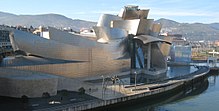Bilbao effect

The Guggenheim Museum in Bilbao with the Ria des Nervión in downtown Bilbao
The term Bilbao Effect describes the targeted upgrading of places through spectacular buildings by architects . The term goes back to the development of the northern Spanish city of Bilbao in connection with the Guggenheim Museum by the American architect Frank O. Gehry , completed in 1997 .
In connection with the soccer World Cup , Wolfgang Maennig used this term in 2010: He said that he saw no prospect of a Bilbao effect in South Africa as a result of the modernization in the host country, since the four premises were not fulfilled at the Cape .
These four premises are:
- central location
- in the vicinity of water
- with innovative , but often not very functional (or even impractical) architecture,
- which is provocative and spectacular at the same time .
Web links
- Rolf Lautenschläger: about a traveling exhibition on the Bilbao effect - taz, April 8, 2008
- ( Page no longer available , search in web archives: Paul Goldberger explains the Bilbao effect ) (video, English)
Individual evidence
- ^ Report of the Heinrich Böll Foundation , accessed on September 14, 2012